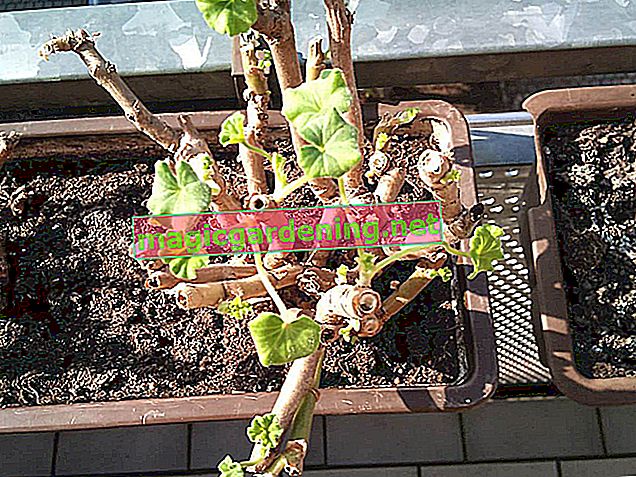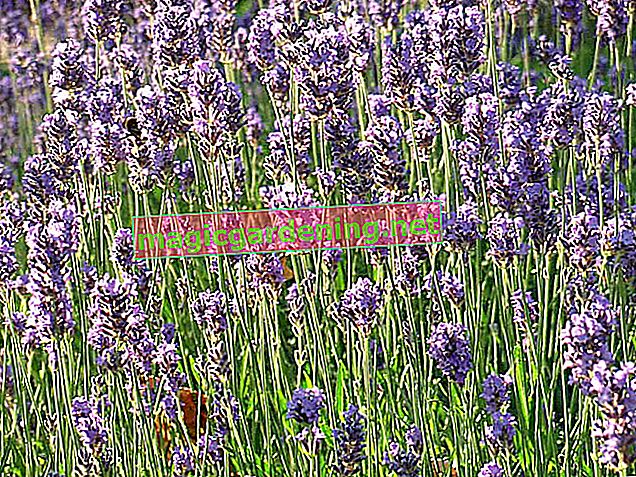
Plant cinquefoil properly
You can plant finger herbs grown in a container all year round. As long as the ground is not frozen or there is a summer drought, the perennials take root in the bed. The best time to plant is in autumn, during the months of September and October. Prepare the soil loosely and free of weeds in accordance with the selected species and variety. Soil that is too sandy is enriched with compost, while soil that is too nutrient-rich is emaciated with sand. Although the choice of location and the preparation of the soil depend on the type and variety, planting follows this pattern:
- Place the potted young plant with the root ball in water until no more air bubbles rise
- Dig a planting pit with 1.5 times the volume of the root ball
- Plant the potted cinquefoil deep enough to keep the previous planting depth
also read
- Cinquefoil: which species are hardy?
- The cinquefoil - harmless or poisonous?
- The cinquefoil - finding a location is not difficult
Press the soil with your hands without compacting it too much and water it.
Care tips
You will have to look for a perennial with less maintenance than cinquefoil with the lantern. We have put together the few measures for skilful care for you here:
- Watering and fertilization are only required in the event of persistent drought or noble varieties
- Pruning after flowering allows hybrids to flower a second time in autumn
- Winter protection is not required
A prerequisite for this mini care program is a careful choice of location, which is tailored as precisely as possible to the selected species and variety. For example, if you settle a swamp cinquefoil in the gravel bed and a white cinquefoil on the edge of the pond, all maintenance effort will come to nothing.
Continue reading
Which location is suitable?
Within their up to 500 species, the indestructible genus of the finger herbs gives us perennials for almost every location. As long as there is no Egyptian darkness at the chosen location, you will find it. The following selection lists the requirements of proven classics:
- White cinquefoil (Potentilla alba): Sunny, lime-free, rocky and well-drained
- Marsh cinquefoil (Potentilla palustris): Sunny to partial shade, marshy and humus
- Red cinquefoil (Potentilla atrosanguinea): Sunny to partial shade, loamy to sandy and fresh and moist
- Gold cinquefoil (Potentilla aurea): Sunny in any normal garden soil
Not to forget the creeping cinquefoil (Potentilla reptans), which, as a ruderal pioneer, likes to settle in the garden uninvited and is often fought as a weed.
Continue reading
When is the flowering time?
The numerous genus of the cinquefoil offers decorative species with divergent flowering times. Cleverly combined, a flowering perennial can be discovered in the garden during the entire growing season. The following selection may serve for your inspiration:
- Gold cinquefoil (Potentilla crantzii): April to June; Hybrids with second flowering in August
- Large-flowered cinquefoil (Potentilla megalantha): May to July; Hybrids with second flowering in September
- Garden cinquefoil (Potentilla x cultorum): July to August; Hybrids with second flowering in October
- Marsh cinquefoil (Potentilla palustris): July to September
In order to motivate cinquefoil to re-bloom, pruning close to the ground is essential. Alternatively, you can regularly brush off dead flowers with your fingers.
Cut cinquefoil properly
After flowering, cut the perennial back close to the ground, prevent the vigorous seed growth and prevent unwanted self-sowing. On hybrids, you will be rewarded for this effort with an autumn re-bloom. This is a touch sparse than the main flower. With a portion of compost after the cut, you can get the new shoot going.
Continue reading
Pour cinquefoil
Watering of pure cinquefoil species is only necessary in exceptional cases. As a rule, the natural rainfall covers the water requirement. If the drought persists during the summer, you will still not walk past the thirsty plant with the watering can without pampering it with a sip of water. The richly blooming noble hybrids, on the other hand, are always watered when the surface of the earth has dried up.
Fertilize cinquefoil properly
If you cultivate one of the magnificent hybrids in the perennial bed, growth and abundance of flowers will benefit from repeated fertilization. At the start of the season and after the first pruning, put a portion of compost, horn shavings, bark humus or guano granulate on the root disc. In contrast, pure species do not require a supplementary supply of nutrients. If deficiency symptoms appear, such as pale colors and stunted growth, an organic fertilizer gives the perennial new vitality.
Overwinter
Winter protection is a foreign word for cinquefoil species and varieties. The perennials can easily cope with freezing cold down to - 28.8 degrees Celsius. Even a blanket of snow does not prevent early blooming specimens from stretching their first leaves and flowers towards the sun.
Propagate cinquefoil
If you have discovered other corners in the garden that cinquefoil should green, nothing stands in the way of uncomplicated propagation. The following approaches have been tried and tested in the hobby garden for generations:
- Division of the root ball in spring or autumn
- During the summer, cut non-blooming cuttings and let them take root in the pot
- Cut off runners, divide into 5-8 cm long pieces and plant in the poor substrate until roots form
The sowing should also be mentioned at this point; it is noticeable negatively in comparison to the methods mentioned because of the greater amount of work involved. In addition, finger herbs that are propagated from seedlings usually only flower after a few years.
How do I transplant properly?
If you order the perennial to be relocated, the cinquefoil calmly accepts the associated stress. Choose an appointment in autumn or spring. Loosen the root ball with the digging fork so that you can lift it out of the ground with the spade. At the new location, a spacious planting pit should already be prepared so that the cinquefoil can be planted exactly as deep as before. In the following period, regular watering promotes rapid rooting.
Is cinquefoil poisonous?
Cinquefoil is completely free of toxic ingredients. On the contrary, plant parts of the creeping cinquefoil are used in folk medicine. In addition, the knowledgeable housewife uses the sour-tasting leaves to add culinary value to salads and other dishes.
Continue reading
Nice varieties
- Gold Rush: Delicate variety that adorns thin wall crevices or the rock garden with golden yellow flowers; Height 10-15 cm
- Hopwoodiana: Pink blooming variety jewel for the perennial bed with filigree lobed leaves; Growth height 30-40 cm
- Arc-en-Ciel: Fantastically beautiful double cinquefoil with carmine-red, yellow-edged flowers; Height of growth 40-45 cm
- Roxana: Large-flowered cinquefoil, which shows off its salmon-red flowers from July to August; Height 40-50 cm
- Alba: White flowering cinquefoil, a wonderful ground cover for lime-free, stony locations; Height 10-15 cm








